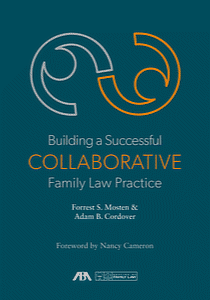 |
Building a Successful Collaborative Family Law Practice
Forrest S. Mosten and Adam B. Cordover, Editors
(2018, Approx. 300 pages, ISBN: 978-1-64105-241-2)

Good through August 2025
|
“This book provides a roadmap for those who have been trained in collaborative practice and want a resource to help build a sustainable flow of collaborative cases and of out-of-court settlement work….This book provides a wide resource of those steps; steps that can be applied not only by lawyers but by all professionals who work in the Collaborative model.”
From the Foreword by Nancy Cameron
This new book, edited by Forrest S. Mosten, an experienced mediator and Collaborative practitioner, and Adam Cordover, an attorney with insights as an emerging leader in the collaborative movement, puts the spotlight on the wisdom and practice-derived insights of 25 authors who command vast experience in the trenches of their collaborative practices.
Table of Contents
Building a Successful Collaborative Family Law Practice
Forrest S. Mosten and Adam B. Cordover, Editors
PROLOGUE: Making Collaborative and Non-Court Practice Your Day Job – Forrest S. Mosten & Adam B. Cordover
- Lawyers as Peacemakers. Really?!? Yes, Really. – David Hoffman
- How Collaborative Practice Will Improve Your Profitability – Robert Merlin
- Redefining Your Practice Signature and Creating a Profitable Peacemaking Practice – Kevin Scudder
- How Many Hats Can You Wear? Assessing If You Can Be a Collaborative Professional and Still Litigate – Carl Michael Rossi
- Being A Client Leader: The Art of Gaining New Collaborative Clients – Rich Grof
- Effectively Marketing Your Collaborative Practice – Gary Direnfeld
- Creating Collaborative Office Space – Zanita Zacks-Gabriel
- Integrating Technology into Your Collaborative Practice – Brian Galbraith
- Getting Buy-In for a Collaborative Approach from the Other Spouse and Attorney – Enid Miller Ponn
- The First Client Meeting: Gateway to a Collaborative Case – Bev Churchill
- Gaining Success at the First Joint Collaborative Meeting – Jeremy Gaies
- Fine-Tuning Your Collaborative Team – Lara Traum
- Developing a Range of Collaborative Models: One Size Does Not Fit All – Ronald D. Ousky
- Mediation and Collaboration: Harnessing Potential Synergy – Elizabeth Potter Scully
- Traits and Skills of a Highly Effective Financial Neutral – J. David Harper
- Collaborative Child Specialists: Traditional and Expanded Roles – Kathleen Zumpano
- Using Behavioral Health Professionals in Family Law (with Supplemental Practice Tips) – Nancy Retsinas and Susan Buniva (with Melissa Sulkowski)
- Collaborative Marriage Planning – Dennis Lerner
- Modifying Existing Agreements with a Collaborative Approach – Kimberly Stamatelos
- Avoiding and Handling Termination of the Collaborative Process – Michael V. Fancher
- Civil Collaborative Practice: The New Way to Do Business – Sherrie R. Abney
- Collaborative Practice as a Business – Brian Galbraith
CONCLUSION: Next Steps to Develop Your Collaborative Practice – Forrest S. Mosten and Adam B. Cordover
More Sample Content and Free Downloads
Praise for Building a Successful Collaborative Family Law Practice
 What a marvelous job Mosten and Cordover have done in weaving together so many great ideas for developing a Collaborative Practice. This should be required reading for any Collaborative professional who is serious about this important work. I am honored to be a contributor.
What a marvelous job Mosten and Cordover have done in weaving together so many great ideas for developing a Collaborative Practice. This should be required reading for any Collaborative professional who is serious about this important work. I am honored to be a contributor.
Ron Ousky, Collaborative Lawyer and Mediator
Past President of the International Academy of Collaborative Professionals
Edina, MN
 I personally believe Woody Mosten and Adam Cordover have done the Collaborative Practice Community a tremendous service by bringing together this group of respected Collaborative Practitioners to share their experience and expertise. They gathered these voices to speak to the Collaborative Practice and peacemaking world, in an attempt to answer the call of the Community for more Collaborative cases and for a way to stop going to court forever. For those who want to devote their life and practice to changing how families resolve their disputes and to help them move forward in peace, this is the book for you.
I personally believe Woody Mosten and Adam Cordover have done the Collaborative Practice Community a tremendous service by bringing together this group of respected Collaborative Practitioners to share their experience and expertise. They gathered these voices to speak to the Collaborative Practice and peacemaking world, in an attempt to answer the call of the Community for more Collaborative cases and for a way to stop going to court forever. For those who want to devote their life and practice to changing how families resolve their disputes and to help them move forward in peace, this is the book for you.
Christopher M. Farish, Collaborative Lawyer
Dallas, TX
President of the International Academy of Collaborative Professionals
 This book is for collaborative practitioners who want to turn their commitment to helping clients achieve wise, respectful, settlements into profitable, satisfying careers out of court. In clear, down-to-earth language, from a variety of contributors, it provides practical advice related to the collaborative process, from the initial client consultation, to high functioning teams, to process models, to avoiding and managing the termination of a CP case. It offers tips and coaching on defining your practice style and space, growing your settlement practice and the nuts and bolts of running a successful, non-litigation business. This book is a welcome resource for peace building-your clients and your own.
This book is for collaborative practitioners who want to turn their commitment to helping clients achieve wise, respectful, settlements into profitable, satisfying careers out of court. In clear, down-to-earth language, from a variety of contributors, it provides practical advice related to the collaborative process, from the initial client consultation, to high functioning teams, to process models, to avoiding and managing the termination of a CP case. It offers tips and coaching on defining your practice style and space, growing your settlement practice and the nuts and bolts of running a successful, non-litigation business. This book is a welcome resource for peace building-your clients and your own.
Victoria Smith, Collaborative Lawyer and Mediator
Toronto, Ontario, Canada
 Collaborative Practice appeals to professionals for many reasons but, once trained, all professionals face the challenge of developing a TRUE Collaborative Practice. This book provides insights from successful Collaborative practitioners and can guide professionals new to the process in coordinating their own evolution. After training, we often hear, “Where are my cases?” This book offers numerous approaches and considerations, along with practice tips, to aid the professional in finding their Collaborative clients and helping them on their journeys, all while managing and growing their practices.
Collaborative Practice appeals to professionals for many reasons but, once trained, all professionals face the challenge of developing a TRUE Collaborative Practice. This book provides insights from successful Collaborative practitioners and can guide professionals new to the process in coordinating their own evolution. After training, we often hear, “Where are my cases?” This book offers numerous approaches and considerations, along with practice tips, to aid the professional in finding their Collaborative clients and helping them on their journeys, all while managing and growing their practices.
Lynda J. Robbins, Mediator and Counselor at Law
Boston, MA
Past President and Executive Director, International Academy of Collaborative Professionals
 This book is a must read for Collaborative practitioners who want to learn how to build on their training and assist more of their clients to achieve the respectful, dignified divorce that all families deserve. This book is an essential guide to convert a passion and commitment to Peacemaking into a successful and sustainable business. Let the collected wisdom of the many extraordinary practitioners contained in this book be your guide to a future filled with personal satisfaction and grateful clients.
This book is a must read for Collaborative practitioners who want to learn how to build on their training and assist more of their clients to achieve the respectful, dignified divorce that all families deserve. This book is an essential guide to convert a passion and commitment to Peacemaking into a successful and sustainable business. Let the collected wisdom of the many extraordinary practitioners contained in this book be your guide to a future filled with personal satisfaction and grateful clients.
Beverly Clark, Collaborative Lawyer
Adelaide, Australia
 A quiet revolution is reshaping modern family law practice, moving it from the courtroom to the conference room. Woody Mosten and Adam Cordover, two of its leaders. have assembled the best practitioners in the field to create a practical guide that helps family lawyers understand and join the collaborative revolution. Their book shows that it is possible to develop and maintain a profitable practice and provide the kind of representation that we went to law school for. It is a gift to the profession and the families and children we serve.
A quiet revolution is reshaping modern family law practice, moving it from the courtroom to the conference room. Woody Mosten and Adam Cordover, two of its leaders. have assembled the best practitioners in the field to create a practical guide that helps family lawyers understand and join the collaborative revolution. Their book shows that it is possible to develop and maintain a profitable practice and provide the kind of representation that we went to law school for. It is a gift to the profession and the families and children we serve.
Andrew Schepard, Official Reporter for Uniform Collaborative Law Act
Siben & Siben Distinguished Professor of Family Law and Director of the Center for Children, Families and the Law
Maurice A. Deane School of Law at Hofstra University
 Insightful. Practical. Inspiring. Building a Successful Collaborative Family Law Practice offers essential tips from experienced professionals committed to the peaceful resolution of family disputes. What is striking about this collection is the generosity of the contributors, who offer their experience and wisdom - gained from “lessons learned” - to help others create professionally and financially rewarding careers outside of court. As a family lawyer who no longer goes to court, I am acutely aware of the pressures our profession faces when we seek more integration between our personal values and our professional lives. We all thank Adam and Woody for pulling together this collection to teach others that it is possible to have an authentic and productive law practice focused on peace.
Insightful. Practical. Inspiring. Building a Successful Collaborative Family Law Practice offers essential tips from experienced professionals committed to the peaceful resolution of family disputes. What is striking about this collection is the generosity of the contributors, who offer their experience and wisdom - gained from “lessons learned” - to help others create professionally and financially rewarding careers outside of court. As a family lawyer who no longer goes to court, I am acutely aware of the pressures our profession faces when we seek more integration between our personal values and our professional lives. We all thank Adam and Woody for pulling together this collection to teach others that it is possible to have an authentic and productive law practice focused on peace.
Jacinta Gallant, Collaborative Lawyer, Mediator and Trainer
Charlottetown, Prince Edward Island, Canada
 Adam Cordover and Woody Mosten are leaders in finding new ways to serve clients in divorce proceedings. This book highlights collaborative law and provides a how-to (and how not-to) guide for practitioners: from the perspective of over 20 experts. It is engaging, highly informative and inspiring. Among other things, the authors recommend that lawyers undertake multi-disciplinary training, hone management expertise and ramp up marketing efforts – all in service of allowing families to ‘make and keep peace’ through the divorce process. Tired of angry clients, demanding judges and divisive processes? Dip into collaborative law, under the tutelage of Cordover and Mosten – win/win for clients and for their lawyers.
Adam Cordover and Woody Mosten are leaders in finding new ways to serve clients in divorce proceedings. This book highlights collaborative law and provides a how-to (and how not-to) guide for practitioners: from the perspective of over 20 experts. It is engaging, highly informative and inspiring. Among other things, the authors recommend that lawyers undertake multi-disciplinary training, hone management expertise and ramp up marketing efforts – all in service of allowing families to ‘make and keep peace’ through the divorce process. Tired of angry clients, demanding judges and divisive processes? Dip into collaborative law, under the tutelage of Cordover and Mosten – win/win for clients and for their lawyers.
Rebecca Love Kourlis, Former Justice, Colorado Supreme Court
Executive Director, Institute for the Advancement of the American Legal System
Denver, CO
 This compilation captures the essence of collaborative practice and its value for families and practitioners. The practical input in each chapter provides both a foundation for new practitioners to learn from an amazing array of experts and a reflective resource for those with experience to hone their skills. It is essential reading for anyone looking to establish a high-quality practice focused on helping families find peace and resolution. The diversity of practice approaches, professional disciplines, and personal insights makes this book an invaluable resource for all professionals who want to join the growing numbers of us committed to changing the culture of family law in a positive way for families.
This compilation captures the essence of collaborative practice and its value for families and practitioners. The practical input in each chapter provides both a foundation for new practitioners to learn from an amazing array of experts and a reflective resource for those with experience to hone their skills. It is essential reading for anyone looking to establish a high-quality practice focused on helping families find peace and resolution. The diversity of practice approaches, professional disciplines, and personal insights makes this book an invaluable resource for all professionals who want to join the growing numbers of us committed to changing the culture of family law in a positive way for families.
Susan Hansen, Collaborative Family Lawyer and Mediator
Past President, International Academy of Collaborative Professionals
Milwaukee, WI
 Woody has done it again! This time, he had help from Adam Cordover whose additions proved to be everything you would want from a co-editor. The chapter contributions were from the most stellar leaders in the field, the organization of the book truly lends itself to being the premier guide for building a practice that is client-centered, client-focused, and client-driven. For too long, family law practitioners have utilized a slash and burn approach to reshaping families when spouses decide to part ways. I sincerely hope this book has a prominent place on the shelves of all family law practitioners and becomes a prominent tool in the family lawyer toolbox.
Woody has done it again! This time, he had help from Adam Cordover whose additions proved to be everything you would want from a co-editor. The chapter contributions were from the most stellar leaders in the field, the organization of the book truly lends itself to being the premier guide for building a practice that is client-centered, client-focused, and client-driven. For too long, family law practitioners have utilized a slash and burn approach to reshaping families when spouses decide to part ways. I sincerely hope this book has a prominent place on the shelves of all family law practitioners and becomes a prominent tool in the family lawyer toolbox.
Linda Warren Seely, Director of ABA Dispute Resolution Section
Washington, DC
 Mosten and Cordover’s anthology offers fresh and useful dispute resolution strategies that can be adapted by lawyers and others who would prefer to help resolve family conflict by mutual agreement, rather than in search of a “victory” that too often turns out to be hollow. Woody Mosten has translated his career passion for peacemaking into a far reaching book that will help individuals and organizations better resolve disputes and prevent future conflict.
Mosten and Cordover’s anthology offers fresh and useful dispute resolution strategies that can be adapted by lawyers and others who would prefer to help resolve family conflict by mutual agreement, rather than in search of a “victory” that too often turns out to be hollow. Woody Mosten has translated his career passion for peacemaking into a far reaching book that will help individuals and organizations better resolve disputes and prevent future conflict.
Stephen B. Goldberg
Emeritus Professor, Northwestern School of Law
Author: How Mediation Works: Theory, Research, and Practice (2017) (Co-authored by Jeanne M. Brett and Beatrice Blohorn-Brenneur), and Dispute Resolution: Negotiation, Mediation, Arbitration, and Other Processes, 6th edition (2012) (Co-authored by Frank E. A. Sander, Nancy H. Rogers, and Sarah R. Cole).
Chicago, IL
 Feeling a bit estranged from litigation in your Family Law practice? Thinking about a dissolution of those ties, but concerned about personal finances, professional identity, and skills development you were to develop a new relationship with Collaborative Practice? For advice about the decision and a survival manual once you have made the commitment, look no further than Building a Successful Collaborative Family Law Practice, by Forrest S. Mosten and Adam B. Cordover (2018).
Feeling a bit estranged from litigation in your Family Law practice? Thinking about a dissolution of those ties, but concerned about personal finances, professional identity, and skills development you were to develop a new relationship with Collaborative Practice? For advice about the decision and a survival manual once you have made the commitment, look no further than Building a Successful Collaborative Family Law Practice, by Forrest S. Mosten and Adam B. Cordover (2018).
In its themes and organization, this brilliant compendium mimics the very qualities it describes and inspires among collaborative professionals. It reflects upon, and commits to, a strong set of values and principles; empathizes with the needs of its audience; engages the reader as a partner in a flexible journey, within an interdisciplinary team; and offers clear summaries and concrete tips. This book opens hearts, minds, meaning, and opportunities even as it navigates realistically what for many will be new and challenging professional terrain.
Thomas Barton, Professor of Law, California Western University School of Law
San Diego, CA
 This comprehensive set of essays about building a collaborative law practice is full of gems. Always keeping a commitment to peace-making and care for long-term health of family members at the forefront, it describes a variety of models of collaborative law and discusses when to use a hybrid approach with elements of mediation and of collaborative law. Chapters such as the one about collaborative marriage planning introduce new ways collaborative law practitioners can assist families. Woody Mosten, Adam Cordover, and the contributing authors of the book have assembled a complete manual about how to serve your clients well and how to build your collaborative law practice.
This comprehensive set of essays about building a collaborative law practice is full of gems. Always keeping a commitment to peace-making and care for long-term health of family members at the forefront, it describes a variety of models of collaborative law and discusses when to use a hybrid approach with elements of mediation and of collaborative law. Chapters such as the one about collaborative marriage planning introduce new ways collaborative law practitioners can assist families. Woody Mosten, Adam Cordover, and the contributing authors of the book have assembled a complete manual about how to serve your clients well and how to build your collaborative law practice.
Virginia L. Colin, Ph.D., President, Academy of Professional Family Mediators
Springfield, VA
 When I began reading this book one afternoon, I could not put it down until I had read every page. This is THE book for building a collaborative family law practice. Forrest Mosten and Adam Cordover have assembled an amazing collection of collaborative professionals to explain in detail the essential keys to successfully establishing a collaborative practice. In step by step explanation, the book details the process necessary to implement a practice. Training, networking, office setting, working in the inter-professional environment, the importance of the first meeting, and steps to avoid impasse are all explained in a most useful manner. Every collaborative professional should have this book.
When I began reading this book one afternoon, I could not put it down until I had read every page. This is THE book for building a collaborative family law practice. Forrest Mosten and Adam Cordover have assembled an amazing collection of collaborative professionals to explain in detail the essential keys to successfully establishing a collaborative practice. In step by step explanation, the book details the process necessary to implement a practice. Training, networking, office setting, working in the inter-professional environment, the importance of the first meeting, and steps to avoid impasse are all explained in a most useful manner. Every collaborative professional should have this book.
Harry L Tindall, Lawyer and Collaborative Professional
Uniform Law Commissioner and principal backer of the Uniform Collaborate Law Act
Recipient of ABA Lawyer as Problem Solver Award
Houston, TX
 Thank you to Woody and Adam for your insight, time and efforts in creating a book for new and experienced collaborative professionals. I found this book to answer the most frequently asked questions by those new to this specialized field and address them in a practical and usable manner. Having input from so many respected professionals in our field only heightens the value of this book. It is a must-read for those who are new to collaborative practice and will serve as a good refresher for those of us who have been practicing for years.
Thank you to Woody and Adam for your insight, time and efforts in creating a book for new and experienced collaborative professionals. I found this book to answer the most frequently asked questions by those new to this specialized field and address them in a practical and usable manner. Having input from so many respected professionals in our field only heightens the value of this book. It is a must-read for those who are new to collaborative practice and will serve as a good refresher for those of us who have been practicing for years.
Linda Solomon, LPC, LMFT, Collaborative Trainer and Neutral Mental Health Professional
Co-Founder of the One Coach/Texas Model of Collaborative Practice
Ashville, NC
 The growth of collaborative practice is enhanced by a new anthology from the ABA. Forrest “Woody” Mosten and Adam Cordover have assembled 22 creative and well-researched articles they accurately call a “tool kit” for collaborative professionals. With their own introductions, prologue and conclusions, and many resources along the way, they make the case for collaborative law as not only a viable process, but often a better path. They address how to set up a collaborative practice, grow it, make it profitable, and carry it out effectively. Collaborative attorneys may consider this book as an investment in a satisfying professional future.
The growth of collaborative practice is enhanced by a new anthology from the ABA. Forrest “Woody” Mosten and Adam Cordover have assembled 22 creative and well-researched articles they accurately call a “tool kit” for collaborative professionals. With their own introductions, prologue and conclusions, and many resources along the way, they make the case for collaborative law as not only a viable process, but often a better path. They address how to set up a collaborative practice, grow it, make it profitable, and carry it out effectively. Collaborative attorneys may consider this book as an investment in a satisfying professional future.
Lawrence D. Gaughan, Mediator and Collaborative Lawyer
Author: Concepts, Strategies and Skills for Divorce Professionals
Potomac Falls, VA
 This book delivers more than what its title suggests. Collaborative financial professionals will find both inspiration and practical tips in the chapters of this book. I can see that this book will become a well-worn reference on my shelf that I will return to often for guidance and useful ideas I can implement in my practice as a professional Peacemaker. David Harper’s chapter on “Traits and Skills of a Highly Effective Financial Neutral” is a must-read for both more and less experienced financial neutrals. Thanks to all the amazing collaborative professionals that contributed their valuable insights to this book!
This book delivers more than what its title suggests. Collaborative financial professionals will find both inspiration and practical tips in the chapters of this book. I can see that this book will become a well-worn reference on my shelf that I will return to often for guidance and useful ideas I can implement in my practice as a professional Peacemaker. David Harper’s chapter on “Traits and Skills of a Highly Effective Financial Neutral” is a must-read for both more and less experienced financial neutrals. Thanks to all the amazing collaborative professionals that contributed their valuable insights to this book!
Kristen Dimeo, CPA, Collaborative Trainer and Financial Neutral
Tampa, FL
 Many of us who became family law attorneys aspired to assist individuals through family transitions offering hope for a better future. Too often, however, we lost sight of our compass as the realities of the legal system and our professional and personal lives set in – the need to work within the confines of court procedure, immutable statutes and a sea of case law, set against the desire to build a strong reputation and the need to support our families. Woody and Adam brought together the best Collaborative professionals who faced this reality and successfully paved an alternative path forward, using Collaborative lawyering. Building a Successful Collaborative Family Law Practice is a compilation of their ideas and concrete steps for establishing an economically sound peacemaking law practice, congruent with aspirations to best assist clients through family change. This book is a must read for any family law attorney who has secretly or not so secretly desired to build such a practice but questioned the viability of doing so.
Many of us who became family law attorneys aspired to assist individuals through family transitions offering hope for a better future. Too often, however, we lost sight of our compass as the realities of the legal system and our professional and personal lives set in – the need to work within the confines of court procedure, immutable statutes and a sea of case law, set against the desire to build a strong reputation and the need to support our families. Woody and Adam brought together the best Collaborative professionals who faced this reality and successfully paved an alternative path forward, using Collaborative lawyering. Building a Successful Collaborative Family Law Practice is a compilation of their ideas and concrete steps for establishing an economically sound peacemaking law practice, congruent with aspirations to best assist clients through family change. This book is a must read for any family law attorney who has secretly or not so secretly desired to build such a practice but questioned the viability of doing so.
Linda Wray, Collaborative Attorney
Edina, MN
Past President, International Academy of Collaborative Professionals
 Woody and Adam have put together the ultimate guide to developing a Collaborative practice. Whether you are just starting out or have been working at building your own Collaborative practice, this book is must reading. This is the most comprehensive “how-to” on developing a successful practice. For me, it reinforced much of what I am currently doing and gave me so much more to think about and so much more to implement. If every Collaborative professional read this book I believe the failure rate of 11% would be even lower.
Woody and Adam have put together the ultimate guide to developing a Collaborative practice. Whether you are just starting out or have been working at building your own Collaborative practice, this book is must reading. This is the most comprehensive “how-to” on developing a successful practice. For me, it reinforced much of what I am currently doing and gave me so much more to think about and so much more to implement. If every Collaborative professional read this book I believe the failure rate of 11% would be even lower.
Edward Sachs, CPA and Collaborative Financial Professional
Aventura, FL
President, Florida Academy of Collaborative Professionals
 Over the years of working with hundreds of Collaborative Practitioners all over the State of California as a former President and board member of Collaborative Practice California (CP Cal), I have found a common theme. Many folks want to be peacemakers in their practices. They just don’t know how to do it as a successful business. All too often, they give up. Adam and Woody have masterfully assembled an amazing collection of real-world advice from some of the most successful peacemakers in the world to give even the most apprehensive practitioners tools to build a successful and fulfilling Collaborative Practice. I heartily endorse this great work.
Over the years of working with hundreds of Collaborative Practitioners all over the State of California as a former President and board member of Collaborative Practice California (CP Cal), I have found a common theme. Many folks want to be peacemakers in their practices. They just don’t know how to do it as a successful business. All too often, they give up. Adam and Woody have masterfully assembled an amazing collection of real-world advice from some of the most successful peacemakers in the world to give even the most apprehensive practitioners tools to build a successful and fulfilling Collaborative Practice. I heartily endorse this great work.
Shawn Weber, Collaborative Lawyer & Mediator
Past President, Collaborative Practice California
Solana Beach, CA
 What a gem! A guidebook and much more, this well-written book provides tools and a framework for family lawyers desiring to limit their practices to out-of-court conflict resolution. New and experienced family lawyers will find in this book a roadmap to make the paradigm shift to being true peacemakers. Not only does it provide useful practice tips and guidelines, it helps lawyers identify a path for building value-based practices. As a mental health collaborative coach who has championed the concept of a good divorce for over 25 years, I welcome these new peacemakers who have the potential to transform the process of divorce.
What a gem! A guidebook and much more, this well-written book provides tools and a framework for family lawyers desiring to limit their practices to out-of-court conflict resolution. New and experienced family lawyers will find in this book a roadmap to make the paradigm shift to being true peacemakers. Not only does it provide useful practice tips and guidelines, it helps lawyers identify a path for building value-based practices. As a mental health collaborative coach who has championed the concept of a good divorce for over 25 years, I welcome these new peacemakers who have the potential to transform the process of divorce.
Constance R. Ahrons, Ph.D.
Author, The Good Divorce and We’re still Family
Professor Emerita, USC
Former Director of the Marriage and Family Therapy Training Program
 You probably know – or at least know of – Forrest (Woody) Mosten. He is the award-winning mediator, lawyer, and peacemaker who is called the “father of unbundling,” referring to the process of offering legal clients discrete services as distinct from a complete bundled representation, as lawyers traditionally provide. He also is a prominent collaborative lawyer.
You probably know – or at least know of – Forrest (Woody) Mosten. He is the award-winning mediator, lawyer, and peacemaker who is called the “father of unbundling,” referring to the process of offering legal clients discrete services as distinct from a complete bundled representation, as lawyers traditionally provide. He also is a prominent collaborative lawyer.
Woody is a good friend and we co-authored several articles about collaborative practice. He is simultaneously extremely idealistic and extremely pragmatic as is obvious when reading his books and other publications.
You may not know Adam B. Cordover, a relatively new collaborative lawyer in Tampa, Florida. Together, Woody and Adam edited a new book published by the ABA Family Law Section, Building a Successful Collaborative Family Law Practice, which will be released soon. This follows Woody’s 2009 book, Collaborative Divorce Handbook: Helping Families Without Going to Court.
As you may know, collaborative practice involves a “participation agreement” by parties to negotiate without engaging in contested litigation. The parties agree to provide all relevant information and practitioners try to use interest-based negotiation. If any party decides to litigate the matter, all the lawyers must withdraw from the case and are disqualified from representing the parties in litigation. The vast majority of collaborative cases are in family law matters. In 2009, the Uniform Law Commission adopted the Uniform Collaborative Law Act (UCLA), which has been enacted by 17 states and the District of Columbia. In 2011, I published An Empirical Analysis of Collaborative Practice, summarizing the empirical research that had been published to date.
Woody and Adam’s new book is intended for people who are doing collaborative practice or want to do so. It includes 22 chapters written by experienced collaborative practitioners about the nuts and bolts of doing collaborative practice and making a living at it.
The chapters deal with becoming a collaborative practitioner, techniques for collaborative practice, working with a range of other professionals as part of a collaborative team, use in marriage planning and civil cases, and business aspects of running a collaborative practice. The concise chapters are easy to read and include practical tips.
I was particularly pleased to see a chapter by Michael V. Fancher on avoiding and handling termination of collaborative cases. When the collaborative movement really started taking off in the 2000s, many collaborative practitioners were understandably enthusiastic about this exciting new form of practice. In their enthusiasm, it was hard for some to believe that it could be problematic. While most cases worked out well, the collaborative structure itself created risks that parties could abuse the process to take advantage of the other side (especially in cases involving domestic abuse) and that parties could feel trapped in an expensive process that they couldn’t get out of. Over time, the field matured, recognized the risks, and developed processes to anticipate, avoid, and deal with them. The UCLA requires that, before undertaking a collaborative representation, lawyers must assess the appropriateness of collaborative practice and obtain clients’ informed consent. Mr. Fancher’s chapter provides excellent advice about this.
If you want to learn the latest thinking about how to be a successful collaborative practitioner, Woody and Adam’s book is a great place to start.
John Lande
Isidor Loeb Professor Emeritus
University of Missouri School of Law
Author of Lawyering with Early Planned Negotiation
This review was published on July 20, 2018 on the Blog Indisputably authored by Professor Lande